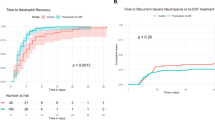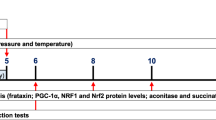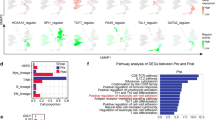Abstract
Granulocyte colony-stimulation factor (G-CSF) is a cytokine that selectively promotes growth and maturation of neutrophils and may modulate the cytokine response to inflammatory stimuli. The purpose of this study was to examine the effect of G-CSF on ex vivo peripheral blood mononuclear cell (PBMC) functions. Ten patients with breast cancer were included in a clinical trial in which r-metHuG-CSF was administrered daily for 5 days to mobilize peripheral blood stem cells. Ten healthy women were also included as controls. Our data show that G-CSF treatment induces an increase in peripheral blood leucocyte, neutrophil, lymphocyte and monocyte counts. We have found a modulation in the percentages of CD19+, CD45+CD14+, CD4+CD45RA+ and CD4+CD45RO+ cells in PBMC fractions during G-CSF treatment. We have also found a significant reduction in the proliferative response of PBMC to mitogenic stimulation that reverted 14 days after the fifth and the last dose of G-CSF. Furthermore, it was not associated with significant changes in the pattern of cytokine production. The mechanism of this immunoregulatory effect is probably indirect since G-CSF receptor has not been found in T lymphocytes. This mechanism and its potential clinical applications remain to be elucidated.
Similar content being viewed by others
Article PDF
Change history
16 November 2011
This paper was modified 12 months after initial publication to switch to Creative Commons licence terms, as noted at publication
References
Aoki, Y., Hiromatsu, K., Kobayashi, N., Hotta, T. & Saito, H. (1995) Protective effect of granulocyte colony-stimulating factor against T-cell mediated lethal shock triggered by superantigens. Blood 86: 1420–1427.
Avalos, B. (1996) Molecular analysis of the granulocyte colony-stimulating factor receptor. Blood 88: 761–777.
Bensinger, W. I., Weaver, C. H., Appelbaum, F. R., Rowley, S., Demirer, T., Sanders, J., Storb, R. & Buckner, C. D. (1995) Transplantation of allogeneic peripheral blood stem cells mobilized by recombinant human granulocyte colony-stimulating factor. Blood 85: 1655–1658.
Boyum, A. J. (1968) Isolation of mononuclear cell and granulocytes from human blood. Scan J Clin Lab Invest 21: 77–89.
Bronchud, M. H., Scarffe, J. H., Thatcher, N., Crowther, D., Souza, L. M., Alton, N. K., Testa, N. G. & Dexter, T. M. (1987) Phase I/II study of recombinant human granulocyte colony-stimulating factor in patients receiving intensive chemotherapy for small cell lung cancer. Br J Cancer 56: 809–813.
Buttke, T. M. & Sandstrom, P. A. (1994) Oxidative stress as a mediator of apoptosis. Immunol Today 15: 7–10.
Dale, D. C., Liles, C., Summer, W. R. & Nelson, S. (1995) Review: Granulocyte colony-stimulating factor-role and relationship in infection diseases. J Infect Dis 172: 1061–1075.
De Jong, R., Brouwer, M., Miedema, F. & Van Lier, R. A. W. (1991) Human CD8+ T lymphocytes can be divided into CD45RA+ and CD45RO+ cells with different requirements for activation and differentiation. J Immunol 146: 2088–2093.
Dmetri, G. D. & Griffin, J. D. (1991) Granulocyte colony-stimulating factor and its receptor. Blood 78: 2791–2808.
Gorgen, I., Hartung, T., Leist, M., Niehorster, M. & Tiegs, G. (1992) Granulocyte colony-stimulating factor treatment protects rodents against lipopolysaccharide-induced toxicity via suppression of systemic tumor necrosis factor a. J Immunol 149: 918–924.
Green, J. M. & Thompson, C. B. (1994) Modulation of T cell proliferative response by accessory cell interactions. Immunol Res 13: 234–243.
Hartung, T., Docke, W. D., Gantner, F., Krieger, G., Sauer, A., Stevens, P., Volk, H. D. & Wendel, A. (1995) Effect of granulocyte colony-stimulating factor treatment on ex vivo blood cytokine response in human volunteers. Blood 85: 2482–2489.
Kuhns, D. B., Alvord, W. G. & Gallin, J. I. (1995) Increased circulating cytokines, cytokine antagonists, and E-selectin after intravenous administration of endotoxin in humans. J Infect Dis 171: 145–152.
Lieschke, G. J. & Burgess, A. W. (1992) Granulocyte colony-stimulating factor and granulocyte-macrophage colony-stimulating factor. N Engl J Med 327: 99–106.
Molineux, G., Podja, Z., Hampson, I., Lord, B. & Dexter, T. (1990) Transplantation potential of peripheral blood stem cells induced by granulocyte colony-stimulating factor. Blood 76: 2153–2158.
Nakagomi, H., Pisa, P., Pisa, E. K., Yamamoto, Y., Halapi, E., Backlin, K., Juhlin, C. & Kiessling, R. (1995) Lack of interleukin-2 (IL-2) expression and selective expression of IL-10 mRNA in human renal cell carcinoma. Int J Cancer 63: 366–371.
Naparstek, E. (1996) Granulocyte colony-stimulating factor, congenital neutropenia, and acute myeloid leukemia. N Engl J Med 333: 516–518.
Pan, L., Delmonte, J. Jr, Jalonen, C. K. & Ferrara, J. L. (1995) Pretreatment of donor mice with granulocyte colony-stimulating factor polarizes donor T lymphocytes toward type-2 cytokine production and reduces severity of experimental graft-versus-host disease. Blood 86: 4422–4429.
Parnes, J. R. (1982) Molecular biology and function of CD4 and CD8. Adv Immunol 44: 265–312.
Pollmacher, T., Korth, C., Mullington, J., Schreiber, W., Sauer, J., Vedder, H., Galanos, C. & Holsboer, F. (1996) Effects of granulocyte colony-stimulating factor on plasma cytokine and cytokine receptor levels and on the in vivo host response to endotoxin in healthy men. Blood 87: 900–905.
Roe, T. F., Coates, T. D., Thomas, D. W., Miller, J. H. & Gilsanz, V. (1992) Brief report: treatment of chronic inflammatory bowel disease in glycogen storage disease type Ib with colony-stimulating factors. N Engl J Med 326: 1666–1669.
Roilides, E., Walsh, T., Pizzo, P. A. & Rubin, M. (1991) Granulocyte colony-stimulating factor enhances the phagocytic and bactericidal activity of normal and defective human neutrophils. J Infect Dis 163: 579–583.
Roman, L. I., Manzano, L., De la Hera, A., Abreu, L., Rossi, I. & Alverez-Mon, M. (1996) Expanded CD4+CD45RO+ phenotype and defective proliferative response in T lymphocytes from patients with Crohn’s disease. Gastroenterology 110: 1008–1019.
Schmitz, N., Dreger, P., Suttorp, M., Rohwedder, E. B., Haferlach, T., Loffler, H., Hunter, A. & Russell, N. H. (1995) Primary transplantation of allogeneic peripheral blood progenitor cells mobilized by filgrastim (granulocyte colony-stimulating factor). Blood 85: 1666–1672.
Shimoda, K., Okamura, S., Harada, N. & Niho, Y. (1992) Detection of the granulocyte colony-stimulating factor receptor using biotinylated granulocyte colony-stimulating factor: presence of granulocyte colony-stimulating factor receptor on CD34-positive hematopoietic progenitor cells. Res Exp Med 192: 245–255.
Sica, S., Rutella, S., Di Mario, A., Salutari, P., Rumi, C., Ortu la Barbera, E., Etuk, B., Menichella, G., D’Onofrio, G. & Leone, G. (1996) rhG-CSF in healthy donors: mobilization of peripheral hemopoietic progenitors and effect on peripheral blood leukocytes. J Hemother 5: 391–397.
Sullivan, G. W., Carper, H. T. & Mandell, G. L. (1993) The effect of three human recombinant hematopoietic growth factors (granulocyte-macrophage colony-stimulating factor; granulocyte colony-stimulating factor, and interleukin-3) on phagocyte oxidative activity. Blood 81: 1863–1870.
Szamel, M., Leufgen, H., Kurrle, R. & Resch, K. (1995) Differential signal transduction pathways regulating interleukin-2 sysnthesis and interleukin-2 receptor expression in stimulated human lymphocytes. Biochim Biophys Acta 1235: 33–42.
Terashima, T., Soejima, K., Waki, Y., Nakamura, H., Fujishima, S., Suzuki, Y., Ishizaka, A. & Kanazawa, M. (1995) Neutrophils activated by granulocyte colony-stimulating factor suppress tumor necrosis factor-alpha release from monocytes stimulated by endotoxin. Am J Respir Cell Mol Biol 13: 69–73.
Tsuji, T., Nagata, K., Koike, J., Todoroki, N. & Irimura, T. (1994) Induction of superoxide anion production from monocytes an neutrophils by activated platelets through the P-selectin-sialyl Lewis X interaction. J Leukoc Biol 56: 583–587.
Vechiarelli, A., Monari, C., Baldelli, F., Pietrella, D. & Retini, C. (1995) Beneficial effect of recombinant human granulocyte colony-stimulating factor on fungicidal activity of polymorphonuclear leukocytes from patients with AIDS. J Infect Dis 171: 1448–1454.
Welte, K., Gabrilove, J., Bronchud, M., Platzer, E. & Morstyn, G. (1996) Filgrastim (r.-metHuG-CSF): the first 10 years. Blood 88: 1907–1929.
Author information
Authors and Affiliations
Rights and permissions
From twelve months after its original publication, this work is licensed under the Creative Commons Attribution-NonCommercial-Share Alike 3.0 Unported License. To view a copy of this license, visit http://creativecommons.org/licenses/by-nc-sa/3.0/
About this article
Cite this article
Reyes, E., García-Castro, I., Esquivel, F. et al. Granulocyte colony-stimulating factor (G-CSF) transiently suppresses mitogen-stimulated T-cell proliferative response. Br J Cancer 80, 229–235 (1999). https://doi.org/10.1038/sj.bjc.6690344
Received:
Revised:
Accepted:
Published:
Issue date:
DOI: https://doi.org/10.1038/sj.bjc.6690344
Keywords
This article is cited by
-
G-CSF mobilized vs conventional donor lymphocytes for therapy of relapse or incomplete engraftment after allogeneic hematopoietic transplantation
Bone Marrow Transplantation (2013)
-
Higher doses of CD34+ peripheral blood stem cells are associated with increased mortality from chronic graft-versus-host disease after allogeneic HLA-identical sibling transplantation
Leukemia (2003)
-
Differential effects of G-CSF mobilisation on dendritic cell subsets in normal allogeneic donors and patients undergoing autologous transplantation
Bone Marrow Transplantation (2002)
-
Collection of hematopoietic stem cells from patients with autoimmune diseases
Bone Marrow Transplantation (2001)



